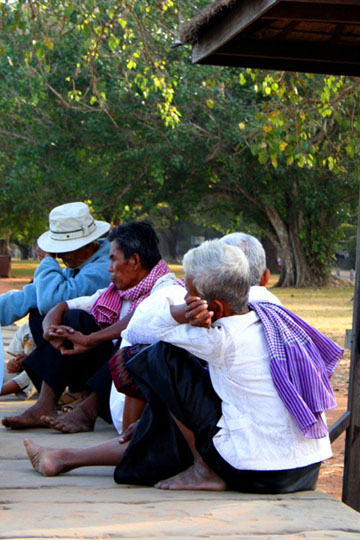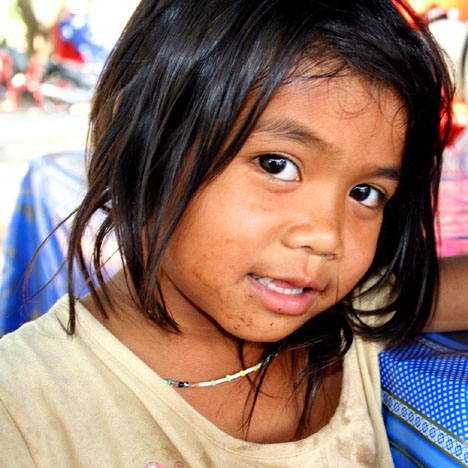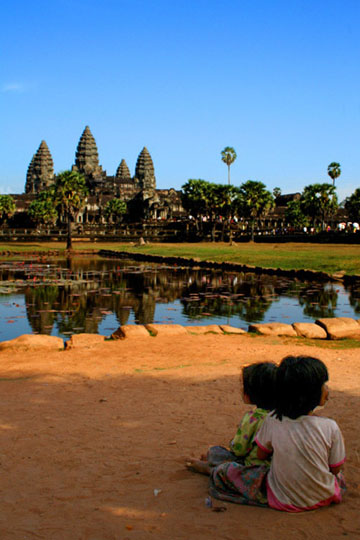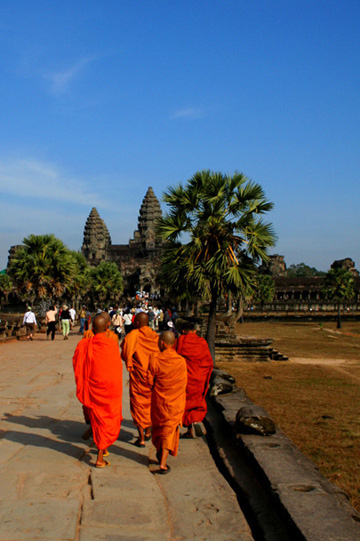Like ducks in a shooting gallery, spotted, sized up and claimed; the cross hairs zeroed in. All that is left is the baggin’ and taggin’. The sun is bright, the sky incredibly blue, the surrounding trees far too distant to cut the afternoon’s glare, and touri frolic happily under bullet holes, souvenirs of the locals’ attempt to claim what was already theirs; a skirmish of class as bloody as only a family squabble can be. Angkor Wat. The Big Kahuna of Cambodian wats. Its image flies on the country’s flag beckoning touri from all over the world, calling to those on the prowl for the historic and the exotic.
More than half of the visitors in Siem Reap head out to Angkor Wat for the sunrise. It’s the preferred time of day to visit the temple, the sun’s early play of colors but frosting on the cake. In my book it’s the worst time of day to visit unless you want to spend quality time with the hordes of backpackers you left puking in the gutters on Pub Street the night before. With no alarm set, no crowded bus to board, and a plan to laze the morning away in bed, I’ll miss the famous sunrise. No problemo. I can always Photoshop it in later.
By 10am I’m up, still an ungodly hour in my mind, but caffeine is a necessity and I’ve only an hour before Tony, my personal tuk tuk driver, guide, and fellow hangover enthusiast is scheduled to come puttering down the soi. Morning is officially over, but the local shopkeepers are used to the lazy ways of touri and getting a fresh cup of thick, rich coffee requires nothing more than plopping my ass into a chair at one of Siem Reap’s numerous street side cafes. Halfway through my third cup – so strong and black it would kill the unprepared – and just beginning to realize the world exists, Tony makes an unscheduled appearance. Early, a first for any Cambodian in the history of his country, he has hunted me down, though the task proved not to be a difficult one. At my invitation, he joins me for a cup, adding a teaspoon of coffee to his mug of sugar, our respective buzzes similar in effect, different in chemical origin.
Jacked and primed, we soon are off for the twenty minute ride to Angkor Wat, passing crews of old women, palm leaf brooms laggardly rearranging the dust that serves as a street in Siem Reap. Customer-less tuk tuk drivers already settling into the back of their rides for their first nap of the day line the road while a few blurry eyed touri greeting an even later dawn than I amble out into the malicious sun.
Surprisingly, since Angkor Wat is the Main Event, the normal gaggle of snot nosed kids exhorting dollars from passing touri are absent from the entrance to the temple, their place held instead by huddled knots of Khmer seniors listlessly gathered in the shade, silently staring across the moat’s murky waters at a scene that once trumpeted the grandeur of their land. There are no signs pointing toward the path, no guides offering to show you the way, just a brick lined dusty causeway stretching out across the lake-size moat’s turgid water, birthing clusters of lotus apathetically blossoming vivid pink splashes of neon in the stifling heat of the afternoon sun.
Angkor Wat is a picture postcard of incredibly clear skies, jewel toned blues set off by the saffron robes of Buddhist monks, visitors to this historical temple competing for space with pale faced touri from foreign lands. Huge stone lions carved by artists who had never seen one guard the pathway leading across the outer moat. Their likeness frames the distant buildings, a mirage that rises with the heat, studded by a few solitary palm trees stretching skyward serving as pathetic reminders of the tropical locale, the humidity that presses down upon you like the guilty conscious of a convict’s rank soul a better indictaion of Cambodia’s climatical disposition.
The long walk across the causeway suggests a quick pace, a scramble toward the shade of the ancient temple’s sandstone walls, only to find on arrival it is but an illusion. I’m only halfway there, Angkor Wat’s temples and galleries are still another distance off, another causeway to pass over, this one spanning the breadth of an ocean of sunburnt grass, the dust and heat competing for space in the air with an army of dragonflies zeroing in on the few splashes of color that decorate the parched brushland.
But the shade is real and I pause long enough to be cooled, and then amused by a cigarette smoking monk, his ragged robes a dusty gold, legs dangling over the edge of rough hewn block as he laughs a non-monk like roar over something some local says to him. The tone of his laughter tells me he is not laughing with him, but at him, possibly having been scolded, as he lights another smoke off the glowing butt of the one held between his nicotine stained fingers. A flash of blue out of the corner of my eye grabs my attention. A shade of turquoise the gods never considered dandifies a Khmer wedding party posing for formal pictures in traditional attire. Hair, make up, and shiny fabric of no natural origin, solemn faces more appropriate for a wake, form a scene of Daliesque garishness captured for posterity; a photographic reminder of a day spent melting in the heat while flocks of touri snapped pictures to show friends and family back home.
Local men illegally posing as tour guides troll the touri hordes for prospective customers, offering a quick synopsis of what lies ahead. Their spiel like the trailer for a B Movie, offering up all the good parts before a ticket is sold, I pass on the con. I’m not interested in details, the historic record, or modern day man’s version of what the ancient ones intended in building the spatial temple. The Ankgor Wat experience for me will be the ambiance I soak up rambling through the site. If need be I can make up my own stories far richer than the version the touts think touri want to hear. But one hopeful points out the bullet holes decorating the temple’s facade, an offering from the Khmer Rouge I’d have missed on my own.
Past a pair of naga performing their serpentine duty flanking a set of laterite stairs, I climb over and then down again through a dank gallery of little note, the last half of a lengthy hike still before me. Baking in the sun, I stop under the limbs of a few straggling trees, their sheltering shade unable to offer cover for both my head and feet as I rest against a stone balustrade, my presence signally an army of red ants that fresh meat is near. Monks on tour pass by in groups offering photo op after photo op with the main temple as backdrop. A chubby little monk with a green sash accenting his robes stops and smiles, pantomiming his desire to take my picture. Exoticism is in the eye of the beholder. Trudging onward I reach the temple and the first of far too many knee high thresholds that will make this visit more strenuous than an hour spent on a Stairmaster.
Inside I’m greeted by a twenty foot tall statue of Buddha displaying Shiva’s eight arms in mass array. Angkor Wat, the world’s largest religious building, was originally dedicated to the Hindu god Vishnu at the time it was built in the first half of the 12th century as Suryavarman II’s state temple and capital city, redounding his name and securing his place in Cambodia’s history. Following wars and the internal squabbles that have plagued the Khmer people throughout their history, the temple gradually moved from Hindu to Theravada Buddhist use. The imagery of the two religions compete and often merge throughout the galleries and quincunx of towers at the compound’s midst. Extensive decoration, predominantly bas-relief friezes, cover the inner walls depicting a series of large-scale scenes from the Hindu epic the Ramayana. The bas-relief work is a major draw for many touri though the monochromatic spread of artwork does little for me. Larger, highlighted carvings, a bevy of young nubile dancing girls to serve the King – European in form and Thai in function – are of more interest but still can not compete with the gargantuan carved heads of nearby Angkor Thom.
In the middle of the compound a steep set of stairs rise, edging the shrine’s central tower some 150 feet high. Most visitors stand in awe staring at the brave and foolish souls making the trek skyward. An obese German sex tourist, his Thai gogo girlfriend trailing behind and ruing her demands for a free trip to a neighboring country, insists they make the pilgrimage. Her six inch come fuck me heels make it an impossible task. Slipping them off, barefoot, she gamely follows his fat ass, a hemisphere of its own, upward. If she is as eager to please in bed, he’s found himself a winner. A telling demonstration of what a Thai will undergo in her attempt to land a husband she can later dump after making it to his home country and sucking off his life savings, her sacrifice a boon to her family’s future.
Not as fortunate in age or gender, a gnarled old Khmer man bent with age carefully picks his way down the same narrow precipitous steps, stair by stair, balancing woven bamboo baskets of trash, his broom used as a cane. His fortune for the day the heavy toil of cleaning up after visitors to his country’s pride and architectural masterpiece.
I make a circuit through the stone corridors that form a perimeter around the temple, pieces of Buddha littering the sandstone floors worn smooth by the passage of millions of pilgrims and hundreds of years. Sun filled plazas peak into the shadows, most abandoned, some peopled by faux nuns who man small shrines obtaining offerings for the gods and wages for their families from touri willing to trade a dollar or two for a blessing. A candle’s flickering flame barely illuminates a long dark hallway, enticing me into its cool duskiness where yet another local has set up his shrine. His smile, the only facial feature I can make out in the dim light, widens as I approach. His shrine is small, a remanent of a statute of Buddha draped in orange lame cloth, the single tallow candle casting minimal light on the obligatory plate for monetary offerings. He forcibly thumps his chest and smiles. I nod thinking, “Got it. Your shrine.” until again he beats upon himself. Maybe the smile isn’t friendliness or even eagerness for some cash, but a state of craziness in this man who spends his day standing alone in the dark. Thump, yet again, and I notice his stance: ear cocked. When he strikes himself again I hear the echo resonating down the hall. Seeing the fear fade as realization comes into my eyes, he pushes me to stand with my back against the wall so that I too can participate in the masochistic echo trick. My hearty thump produces a weaker echo. And a cough. I really need to quit smoking. I leave him a generous tip and collect yet another knotted yarn bracelet as a blessing, my wrist now sprouting an entire rainbow.
Wandering out to sit on a shaded portico, despite the presence of hundreds, I’m alone and able sit in peace enjoying the momentary serenity, the aura of the ancient temple imparting a sense of wonderment and conveying a reverent soothing to my soul. But at the prime viewing spots, touri gather, groups of Japanese visitors forming a herd and hoarding the available space. Camera in hand, lenses bulging in a bag hanging from my shoulder, I’m often asked to take someone’s picture. They assume I’ll agree because my face fails to match my demeanor. And as often, I take the camera extended toward me, turn, and begin walking away just for the pleasure of the momentary flash of panic on their face. I’m easily amused.
Having spent hours circling the compound searching for the best shot of the day, it’s time to brave the sun again and I debate the wisdom of seeking shelter in the only shade available on the long trek back. Lines of stalls selling the same crap I’ve seen at every wat in the area huddle under the only strand of trees. A few places offering food, drink, and cooling shelter are buried at the far end. The need to hydrate settles the matter. Decision made, I find my way immediately blocked by a pair of women holding out useless woven blankets, either for sale or in supplication. I smile, or maybe sneer, in their direction and angle off the path to a small pond, its mirrored surface dotted with lotus blossoms, a popular spot to photograph the wat’s reflection.
A circuitous route to avoid the souvenir vendors takes me to the furthest food stall, allowing some degree of tranquility and back to the wall seating to keep a wary eye on the trolling merchants. Along with the bottle of water I order, a timid, grubby faced urchin selling postcards arrives, her shy smile showing she doesn’t have the aggressive marketing act down quite yet. In what is becoming a tradition for me in Cambodia, I barter away her sale for a photograph. She understands the need for a smile, but still proffers her dog-eared book of postcards unsure if whether or not they too are included in the deal.
A young woman hovering nearby, emboldened by the little girl’s good fortune, meanders over and introduces herself as Sophon. We chat about the weather, the wat, the dwindling number of tourists since Bush broke the world. I buy her a drink, compliment her on her English and she tells me of a Dutchman – man from Dutch as she puts it – who has befriended her on his frequent trips to Cambodia. An older gent, he helps her with her English and has offered to pay for her schooling. She’s not sure if she should trust him; she’s not sure if his offer of assistance comes from a good heart or a more nefarious purpose is in mind. Cambodia has recently passed legislation that bans foreigners over the age of 50 from marrying a local woman; even the government realizes the value of the country’s only export. I’d like to tell her to be more trusting of the world, but an old guy, comely young girl, and frequent visits to SE Asia arouse my suspicions too.
Eventually she owns up to having a stall. Number 53, though the number of booths are only in the dozens. Sophon invites me to come look at her wares, then at my lack of interest resorts to pitiful begging. Because I am her customer. She explains the cluster of merchants have devised a system to allocate potential customers among their number. As touri are spotted walking across the causeway on their way to the temple, they are singled out, identified, and claimed. I’d been designated ‘Old Army Man’, and I was hers, and hers alone, to fleece. Fleetingly offended at the ‘old’ moniker, the army part makes sense: I’m wearing khaki colored pants, an army green shirt, and my favorite hiking boots bought in Spain decades ago that have travelled the world often enough to have earned frequent flyer miles of their own.
Realizing her next opportunity for a potential customer is far down the rotation, I acquiesce and she leads me to her booth brimming with merchandise I’ve seen a hundred times before. But I crouch down to paw through a plastic basket of metal knick knacks anyway, each piece probably worth twenty-five cents. I figure Sophon will ask for ten dollars, I’ll settle for five, though it would be easier to just pass over some cash and feel my duty has been done. Instead she tries to gouge me for 30 bucks, increasing the trinket’s implied worth by lying, “It old.”
Amused, I point at a badly painted canvas, a rural scene done in oils and saturated in colors not evident in Cambodia’s natural landscape. The potential for bigger bucks brings a gleam to her eyes and she quotes a $75 price, upping the value of the art with a claim it’s been painted by her brother, who must be quite proficient as I’ve already seen the same painting several times in town. With a $10.00 price tag attached. Concern for her plight gets erased by her greed and I tell her I’m sorry but her merchandise is beyond the depth of my wallet. Shaking my head, I walk back to the causeway as she sarcastically shouts at my back, “You want free then!?”
I’m not sure if her comment alludes to her merchandise or to the only other thing she has of value to offer an old farang, but her disappointment that so quickly turned to anger makes me wonder if her man from Dutch has yet experienced the shrew hidden in her soul.
Possibly Tony, my tuk tuk driver, too has identified me as Old Army Man as he has spotted me among the touri throngs far enough in advance that by the time I reach the street and my waiting ride he has bought an ice cold bottle of water to offer as I hop into his ancient machine for the ride back to Siem Reap and another night crawling through the bars on Pub Street.
<<< Previous ‘Fear and Loathing In Phnom Penh” Post
Related Posts You Might Enjoy:













this is a great story. The Cambodians really are masters of the attempted sale! It’s got to be tough squeezing out a living…but no one likes be lied to. Those swarms of kids selling postcards and old guidebooks are so sad. It’s such a shame they aren’t in school instead.
Thanks Glenn –
I’m always torn on those kids. I know that they bring in big money for the family, and that’s needed. But giving them cash just incourages the parents to keep the kid working. And then you drive by one of the numerous schools and see all the kids in their uniforms . . . it is a shame that the postcard sellers miss out on a better future.